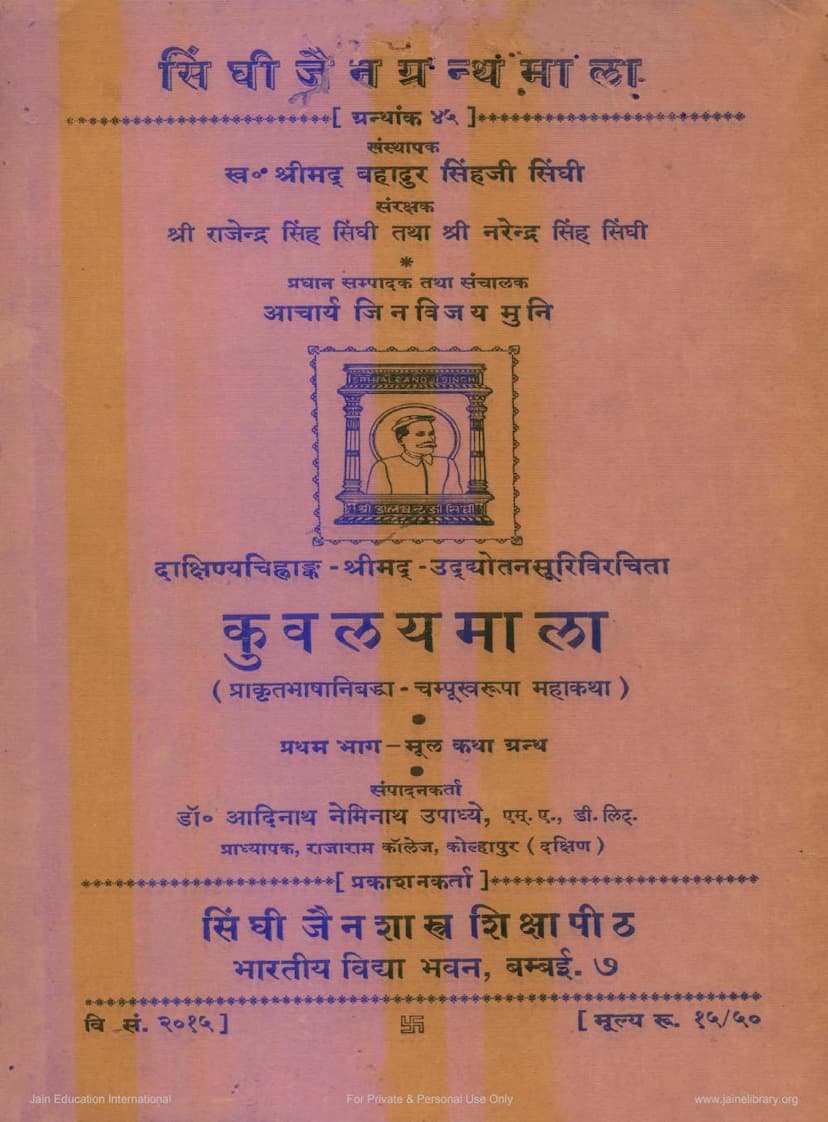Kuvalayamala Part 1
Added to library: September 2, 2025

Summary
Certainly, here's a comprehensive summary of the provided Jain text, Kuvalayamala Part 1, authored by Udyotansuri and edited by Dr. Adinath Nemnath Upadhye, as published by Bharatiya Vidya Bhavan:
Kuvalayamala Part 1: A Comprehensive Summary
The provided text is the first part of the Kuvalayamala, a significant Mahakatha written in Prakrit by the renowned Jain Acharya Udyotansuri. This edition, published by the Singhi Jain Shastra Shiksha Pith, Bharatiya Vidya Bhavan, Bombay, is critically edited by Professor A. N. Upadhye. The work was established in memory of Seth Sri Dalchandji Singhi by his son, Sri Bahadur Singh Singhi, and is under the patronage of Sri Rajendra Singh Singhi and Sri Narendra Singh Singhi. Acharya Jina Vijaya Muni served as the Director and General Editor. The publication date is Vikrama Samvat 2015 (1959 AD).
Content Overview (Based on the provided pages):
The initial pages (1-12) are dedicated to the publication's details, including the series name (Singhi Jain Granth Mala, Number 45), author, editor, publisher, and dedications. There are also tributes and acknowledgments to the Singhi family for their generous support in establishing and promoting Jain literature.
Page 15 onwards features the Preface by the editor, Professor A. N.5. Upadhye, and the "Kinchit Prastavik" (A Brief Introduction) by Acharya Jina Vijaya Muni. These sections provide crucial background information about the Kuvalayamala and its journey towards publication.
Key Aspects Highlighted:
- Author and Work: Udyotansuri, also known as Dakshinya-chinha Suri, composed the Kuvalayamala, a Mahakatha in Prakrit, around 779 AD in Rajasthan (Jalor). The text is noted for its extensive narrative, complex structure (stories within stories), and rich descriptions of various aspects of life and culture.
- Manuscripts: Professor Upadhye critically edited the Prākrit text from two available manuscripts: one on paper in Poona (P) and the other on palm-leaf in Jaisalmer (J). Both were utilized for the edition.
- Editorial Process: The preface details the arduous and extensive process of critically editing the Kuvalayamala, emphasizing the significant textual variations found between the manuscripts. Professor Upadhye highlights the challenges of deciphering ancient scripts and the meticulous work involved in establishing a reliable text.
- Historical and Literary Significance: The Kuvalayamala is recognized as a unique Campu (a literary genre combining prose and poetry) in Prakrit. It is valued for its historical, literary, and linguistic insights into ancient Indian society, culture, and the evolution of Prakrit and Apabhramsa languages. The text also includes narrative content that helps in understanding the historical context of Jain scholars like Haribhadrasuri.
- Academic Journey: Acharya Jina Vijaya Muni initiated the critical edition of this work as early as 1931. However, due to his numerous other engagements, he couldn't complete it. He generously provided the Jaisalmer manuscript material to Professor Upadhye, who undertook the task with great respect for his wish. The editor expresses deep gratitude for Muni Jinavijaya's help and encouragement.
- Cultural Insights: The Kuvalayamala is lauded for its vivid descriptions of various art forms, customs, and social practices of the time, providing a rich tapestry of ancient Indian life.
- Structure and Content: The Kuvalayamala is a vast work, rich in narrative and philosophical discussions. It delves into topics such as the nature of reality, the human condition, the path to liberation, and the importance of Jain principles like non-violence, austerity, and detachment. The preface mentions that Ratnaprabhasuri's Kuvalayamala-katha, a Sanskrit digest of Uddyotana Suri's work, will be included in the second part, making the narrative accessible to a wider audience.
- Dedication and Patronage: The publication is dedicated to the sacred memory of Sri Dalchandji Singhi, and the series is a testament to the Singhi family's commitment to promoting Jain heritage and scholarship. The Bharatiya Vidya Bhavan played a crucial role in publishing this volume.
Overall Impression:
Kuvalayamala Part 1, as presented in these pages, is a scholarly endeavor to make a significant ancient Jain text available to the academic world and the Jain community. It showcases the dedication of the editors and publishers in preserving and disseminating valuable cultural and religious heritage. The detailed preface and introduction highlight the historical context, the manuscript traditions, and the critical editorial approach taken to present this work.